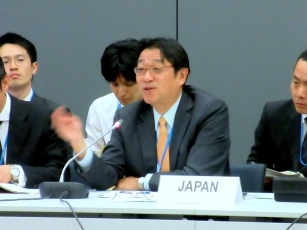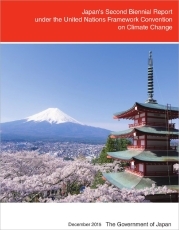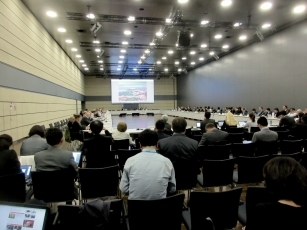Climate Change
The multilateral assessment on the second biennial reports under United Nations Framework Convention on Climate Change



Developed country Parities of the United Nations Framework Convention on Climate Change (UNFCCC) including Japan are requested to submit a biennial report (BR), which consists of climate change measures and policies of the Party based on the decision at COP17 held in Durban and the Cancun Agreements at COP18. The Parities had submitted their second biennial reports by January 1, 2016, and 17 Parties including Japan presented its climate change policy and the progress made till today in the second multilateral assessment (MA2) session during the 46th sessions of the UNFCCC Subsidiary Bodies held in Bonn, Germany, in May, 2017. Japan delivered the presentation on its latest climate change measures and policies on May 12, followed by an active question and answer segment.
Japan’s presentation
Japan introduced the followings pertaining to its climate change measures and policies.
- 2 years in row from 2014, Greenhouse gas (GHG) emissions in Japan decreased due to the progress with energy saving activities and improvement of emission intensity of electricity.
- GHG emissions have increased from 2011 due to the expansion of fossil fuel-fired power plants as a consequence of the suspension of nuclear plants after the Great East Japan Earthquake in 2011. However, this progress with energy saving activities and improvement of emission intensity of electricity helped Japan to reduce its GHG emissions, thus gradually overcoming the impact of the 2011 earthquake and tsunami.
- Japan submitted the 2030 target as its nationally determined contribution (NDC). The target is to achieve 26.0% reduction against 2013, and Japan has been boldly implementing its climate change measures and policies.
- Energy Security, Economic Efficiency, Environment and Safety (“3E + S”) are the basic principles of Japanese energy policy.
- Japanese industrial associations have been tackling with climate change actions through their voluntary action plans (The Commitment to a Low Carbon Society). Besides, Japan has been working on low-carbonization of electricity, improving energy efficiency in industry sector, promoting the introduction of energy conservation appliances and next generation vehicles, tackling with low-carbonization of houses and buildings, and encouraging citizens to take actions with a nationwide campaign called “COOL CHOICE”.
- In line with the commitment made as per G7 Ise-Shima Leaders’ Declaration, relevant ministries in Japan have been considering and discussing the formulation of Japan’s long term strategy.
Question and answer segment
The followings are Japan’s answers to main questions from other Parities.
Sectorial GHG emissions reduction
- Residential sector: Energy consumption per family unit and per person has decreased by around 25% and 13%, respectively, in 2015 compared to those in 2000.
- Residential sector: Estimated emission reduction in 2030 by diffusion of highly energy-efficient equipment is 15MtCO2 and by improvement of the energy efficiency of houses is 10MtCO2.
- Commercial sector: Energy consumption per floor area has decreased by approximately 18% in 2015 compared to that in 2000.
- Commercials sector: The decrease in energy consumption and emissions is expected by implementing Top Runner Programme
 . Estimated amount of emissions reduction is 17 million t-CO2 by 2030. Besides, the reduction of 12 million t-CO2 by 2030 is expected by saving of energy on buildings.
. Estimated amount of emissions reduction is 17 million t-CO2 by 2030. Besides, the reduction of 12 million t-CO2 by 2030 is expected by saving of energy on buildings. - Transportation sector: The emission has decreased continuously since 2001. Japan has been promoting the implementation of the next-generation vehicles such as electric vehicles, plug-in hybrid vehicles, and fuel cell vehicles. Japan has set a goal that, by 2030, the next-generation vehicles account for 50 to 70 % of new auto sales.
Renewable energy
- Japan aims that, in 2030, renewable energy accounts for 22-24% of total electricity generation.
- Japan has implemented National Energy and Environment Strategy for Technological Innovation towards 2050 (PDF)
 in April 2016, promoting research and development on such as renewable energy, storage battery, hydrogen utilization.
in April 2016, promoting research and development on such as renewable energy, storage battery, hydrogen utilization.
Nuclear power plants
- Nuclear power plants are indispensable to realize (1) securing stable energy supply, (2) reducing electricity cost, and (3) reducing CO2 emissions. If the Nuclear Regulation Authority finds a nuclear power plant’s safety level satisfies the strictest standards in the world, it is the government's policy to respect the judgment by the authority and to proceed with the restart of the nuclear power plant. Under this policy, three plants are currently in operation.
The third biennial report
- Japan formulated Plan for Global Warming Countermeasures in May 2016, making it possible to include results of quantitative analysis on climate change countermeasures in the third biennial report.
Multilaterally assessed Parties
Canada, Cyprus, France, Greece, Iceland, Ireland, Japan, Kazakhstan, Liechtenstein, Luxembourg, Monaco, Portugal, Romania, Russian Federation, Slovenia, Spain, United States of America



 (Open a New Window)
(Open a New Window)